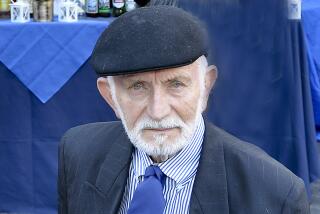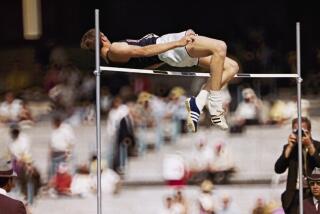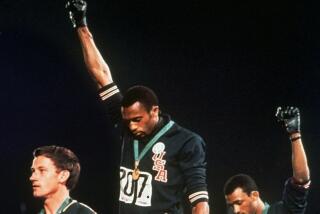We Have Clearance for Takeoff at 7 Feet
The 7-foot high jump has long since lost its magic. It disappeared in 1965, when an Oregon State jumper named Dick Fosbury figured out you could jump higher by going over the bar on your back, instead of your stomach, and 7-foot high jumps became commonplace.
In the 1950s, though, the 7-foot high jump was science-fiction stuff. No one had ever done it. Men had been jumping 6-10 since 1937 but seven feet really seemed to be what it was then called, a barrier.
In the 1950s, the 7-foot high jump had the same ring to it as the 4-minute mile, the 60-foot shotput, the 27-foot long jump, the 16-foot pole vault and the 200-foot discus throw. All those barriers fell between 1954 and 1962.
And on this night 43 years ago, it was the high jump’s turn.
A 19-year-old Compton College athlete named Charlie Dumas broke that barrier, before 20,000 at the U.S. Olympic track and field trials at the Coliseum.
Having already won the event and made the Olympic team, Dumas had the bar raised to 7 feet 1/2 inch. His first attempt was a close miss.
“It was a decent miss,” he recalled.
“I felt fairly confident. There was no pressure. I knew I’d made the plane [to the Melbourne Olympics]. Plus, I’d had attempts at seven feet in competition before. I was relaxed.”
Dumas’ body was seemingly yanked upward by the mighty kick of his right leg. He glided over the bar and landed on his back, in sawdust. The bar trembled . . . but stayed up.
Dumas had to share the next-day headlines, though. On the same night, another barrier fell. Glenn Davis became the first man to break 50 seconds in the 400-meter hurdles, running 49.5.
Also on this date: In 1967, Primo Carnera, at 6-5 3/4 the tallest of all the heavyweight boxing champions, died at 60. Carnera won the title by beating Jack Sharkey in 1933 and lost it to Max Baer in 1934. . . . In 1991, former heavyweight champion Mike Tyson beat Razor Ruddock for the second consecutive time. . . . In 1905, outfielder Archibald “Moonlight” Graham played for the New York Giants in the late innings in his only major league game and did not bat. Years later, he was mentioned in W.P. Kinsella’s novel, “Shoeless Joe,” and was portrayed by Burt Lancaster in the 1989 movie “Field of Dreams.”
More to Read
Go beyond the scoreboard
Get the latest on L.A.'s teams in the daily Sports Report newsletter.
You may occasionally receive promotional content from the Los Angeles Times.










